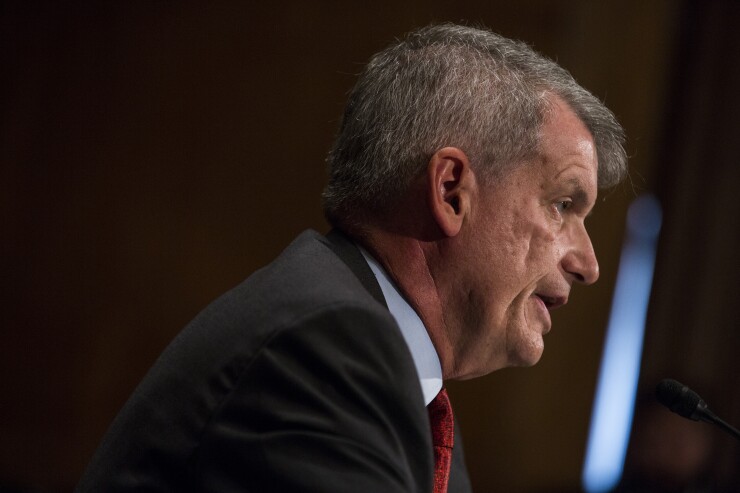You may have spotted a trend in the marketing campaigns of financial institutions in recent years. Advertisers seem just as eager to position themselves as being virtuous as they do to tout the benefits of their products. They are do-gooders who aim to help not just their customers, but the broader community.
"We'll give $150 to Stand Up to Cancer and $150 to you when you open a new checking account," promises a Fifth Third Bank commercial that is representative of the genre.
"Our mission is to make offshore wind one of the principal new sources of energy," a Citigroup banker declares in another ad.
The American public's view of the financial sector went into free fall after the Great Recession, and this sort of image burnishing may help with those lingering negative perceptions. It's an approach being tried by banks and financial technology startups alike, as they seek to improve their reputations with a variety of stakeholders.
Consumers are an important target, but so are current and prospective employees.
"Imagine telling your 22-year-old, fresh-out-of-Stanford, computer science majors, 'We're going to start an amazing, disruptive fintech company, and it's going to make a ton of money charging late fees,' " Max Levchin, chief executive of Affirm, the San Francisco-based online lender, said at an industry conference in October. "Unless you are willing to provide an idealistic narrative, it's actually very hard to disrupt Wall Street."

But there are risks for companies that embrace this sort of virtue signaling, particularly if their corporate cultures do not match the public stories they have been telling about themselves.
"In some cases, the rhetoric is stronger than the reality," warned Stephen Hahn-Griffiths, executive partner at the Reputation Institute.
One example is Wells Fargo. The San Francisco banking giant's onetime tagline — "Together we'll go far" — implied that its interests were aligned with those of its customers.
Then came a series of revelations about widespread misconduct at the $1.9 trillion-asset company. In the most high-profile infraction, as many as 3.5 million accounts were suspected of being opened without customer authorization, as employees tried to hit aggressive sales targets.
In another instance, Wells agreed to refund fees to mortgage customers who were improperly charged to extend the period of time in which they had locked in a specific interest rate. And in a third case, the company pledged to compensate customers who were overcharged for auto insurance.
In each of these scandals, Wells padded its own bottom line by dipping into its customers' pockets. And the public noticed. New checking account openings tumbled in late 2016 and early 2017, after which point Wells stopped publicly reporting the data.
This past spring, Wells unveiled a new ad slogan, "Building Better Every Day," which hinted at the company's problems and could be read as a promise to improve.
"We betrayed your trust, and now it's on us to earn it back," Wells Chief Executive Tim Sloan said in a video message to customers.
Another lender that finds itself in a marketing bind is Social Finance, where brand-building efforts have been complicated by the circumstances surrounding the recent ouster of CEO Mike Cagney.
Since its inception, SoFi has tried to convey that it doesn't just offer its upwardly mobile customers — or members, as it calls them — a lower interest rate on their student loans. The company also helps borrowers find a new job and maybe even a date.
SoFi organizes happy hours, community dinners and speaker series, and getting customer buy-in depends on the premise that the San Francisco-based company is looking out for their interests.
"Community is critical to us to make the SoFi model work," Cagney said in a 2015 interview.
But recent allegations of sexual harassment at SoFi could make that message a tougher sell, particularly among women. "It was a frat house," one former employee told the New York Times.
In a Nov. 9 letter to SoFi shareholders, interim CEO Tom Hutton vowed to make internal changes. "The executive team and I have taken a hard look at SoFi's culture since these allegations, and frankly we see a lot of room for improvement. We are launching a companywide initiative called 'One SoFi' to work with our entire team to define the culture and values we want to embrace," Hutton wrote.
SoFi ultimately may have an easier time rehabbing its image than Wells Fargo. That is partly because the online lender's scandal hasn't resulted in harm to customers. And it is partly because the 6-year-old company didn't have a well-established mass-market brand to tarnish.
Still, SoFi's image as one of the hottest companies in fintech has taken a hit.
The lesson is one that the entire financial services industry would do well to heed. "I think to be authentic, you can't just talk, you also have to walk," Hahn-Griffiths said.





